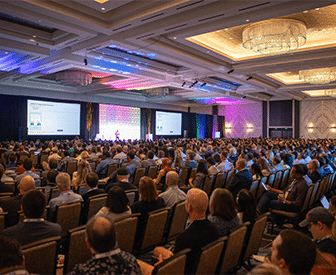In a recent conversation with The Financial Brand’s Jim Marous on the Banking Transformed podcast, Daragh Morrissey, director of AI in world financial services, spoke on the transformative potential of generative AI in the banking industry. With over 15 years of experience at Microsoft, Morrissey’s extensive background and expertise in artificial intelligence make him a valuable resource for insights on the implementation and potential of generative AI in banking.
As banks grapple with the challenges and opportunities presented by this revolutionary technology, Morrissey provides invaluable insights on use cases, adoption patterns, and the future of AI-driven innovation in financial services.
Morrissey paints a compelling picture of how generative AI is reshaping the banking landscape, from enhancing customer experiences and optimizing internal processes to developing new product offerings and fostering a culture of continuous learning.
He offers practical advice for financial institutions seeking to harness the power of this technology — while also addressing the challenges and considerations associated with its implementation.
Q: Can you share a little bit about your role at Microsoft and how the company is partnering with financial institutions to deploy new generative AI solutions?
Daragh Morrissey: I work on the worldwide financial services team, and I’m lucky in my job. I get to see all the innovation taking place across all my customers worldwide. I’m amazed by the wave of interest in this technology and what banks are doing with it. It’s incredible.
In the use cases you mentioned, all banks start with code modernization. One big Wall Street bank has been doing that for about the last two years. And I like talking about it because its benefits are very well understood now that it’s been in the market for two years.
Leveraging Generative AI for Internal Optimization and Customer Engagement
Q: When you look at the use cases around contact centers, fraud detection, and market research, what are the most exciting use cases you’ve seen in the financial services marketplace?
Morrissey: I love the contact center one. Within that use case, there are a couple of different stages you can take. You can just summarize the conversation between you and the customer.
I have one Canadian bank that just wanted to do that and play it back to the customer because anytime I ring a contact center, I never remember what I said, what we agreed on, and sometimes I don’t remember the follow-ups.
The advanced stage of this now is where you can do things like agent assist, where you’re coaching the contact center agent in real-time, and you can do it to do things like track compliance.
You can combine those two use cases so you can learn from every conversation in the bank. You can push it into your knowledge base, and this way, you get a continual learning bank. And it’s learning from every conversation. I believe this is a really intelligent bank.

Navigating Credit Card Issuing in an Uncertain Economic Environment
Build a modern credit card strategy that balances profitability and risk, adopts the latest technology and delivers the customization that cardholders demand.
Read More about Navigating Credit Card Issuing in an Uncertain Economic Environment

Creating A Community with CQRC’s Branch Redesign
Find out how SLD helped CQRC Bank to create the perfect harmony of financial services, local culture, and the human touch in their branch transformation.
Read More about Creating A Community with CQRC’s Branch Redesign
Choosing the Right Co-Pilot
Q: Can you explain the concept of a co-pilot a little bit?
Morrissey: If you think about somebody helping you to do your job or somebody helping you get started on a task and you’re sort of overseeing what they do, I think it’s an ingenious concept that Microsoft invented.
There are several important reasons for it, especially in banking. We know this technology doesn’t get things right all the time. And many of the use cases that banks use have a tolerance of a margin of error. What you need for generative AI is a human to oversee what it’s doing and make sure it’s getting it right.
I’m excited about this concept of a co-pilot who can also do stuff. When we bring it into the Office of Word and PowerPoint, it will not just help you find an answer; it will go and do something — which is exciting to me.
Q: What have you seen in the financial services area around personalization? Have you seen any organizations really start to get it right?
Morrissey: I’ve seen some interesting use cases around financial management. One interesting AI use case is one of our partners’ self-driving financial management solutions. It’s not fully self-driving, but I love that it sort of, if you have extra money left over, it will automatically save it for you.
They’ve also flipped it as well. So, if people are in financial difficulties, they actually used it during the COVID pandemic to help small businesses.
They saw that people were experiencing shortages of money. And I loved that they sort of reached out to the customer and said, “Here are some things that we can do to help, or we can give you a holiday on this mortgage.”
I think where it’s going is that you’ll be able to have a conversation with the bank in a new way when this matures. Being able to naturally talk to your bank will be game-changing.
Building a Roadmap for Generative AI Adoption
Q: As banks are looking to infuse generative AI into products and customer experience solutions, what have you seen that financial institutions have to keep in mind as they’re developing these things to ensure that directionally they’re doing the right thing?
Morrissey: The first use case I would start with is your developers. It’s the most mature generative AI scenario. And as you build new applications for this, why not build them with generative AI?
Then I would think about the out-of-the-box AI, gen AI that you’ll get from us if you start introducing it to Teams and Office. You’ll hit a ton of use cases there that are sort of horizontal across the whole business.
Then, you’ll be left with a set of custom use cases. These could be things like I would start; you could start with a contact center, just enhancing what you currently have in your contact center. You don’t have to rip out your contact center, either. It’s just about sort of adding the capabilities on top.
Building a knowledge base is also a great way of learning how to use this inside the organization. Your product documentation isn’t super sensitive, so it’s not the end of the world if something happens there. This is where a lot of banks started.
Q: When you work with financial institutions, what roles and skills do you see essential for success, and how are organizations now answering that need?
Morrissey: I think allowing people to re-skill and do these roles is more sustainable. Nobody knows the bank’s products better than the people inside the bank and their customers.
One of the things we did as well was create this concept of a citizen developer or citizen data scientist. You could just take a set of data, and we can prompt you to say, “It looks like you need one of these models, that could be sentiment analysis or something.” Then, it will build a model with the data.

Generative AI as a Teaching Tool
Q: How do you envision generative AI as a teaching tool rather than a learning tool? How do you see it as a teaching tool that can move entire sets of employees forward in their careers and personal lives?
Morrissey: I think it is a great tool. One use case that McKinsey had recently was training new wealth advisors with simulated conversations. You can simulate the gen AI, which acts like a customer, and then can score the conversation or coach the advisor, which is cool.
I even pay for ChatGPT myself. I even use it sometimes if I’m meeting a certain person in a bank now. I’m not super deep in capital markets, for example. Sometimes, I will ask it: “Tell me about this person’s job,” or “what are good questions to ask them?”
Now, I don’t trust its outputs a hundred percent, but it gives me enough to get started.
Q: What challenges do you see on the horizon regarding developing and deploying AI solutions and generative AI solutions in the financial services area?
Morrissey: I think one of the challenges is getting more precise on the answers. Now, we are closing that gap at Microsoft in several ways. So, one of the things we can do now is get real-time data into a conversation.
We have these things called plugins, so we can ask, “What is the latest stock price in Microsoft?” And get back an answer. The answer is traceable, and you can see it is what it is.
The other challenge will be integrating it into more applications. Our platform is doing a ton to make that easier. Another pattern I’m seeing is analysis paralysis.
I’m seeing some banks get to a list of 50 use cases, and then somebody comes in and tries to cost them out and assess them. And I just think that’s not a waste of time, but in business cases, they never deliver what they said they would deliver in either direction. So, I think it’s a waste of time. I think you should really get started and learn.

Accelerate Time-to-Market with Rapid Implementation
Create a sustainable competitive advantage with faster time to market by drastically reducing implementation time.
Read More about Accelerate Time-to-Market with Rapid Implementation

Join industry’s leading AI conference - free passes available!
Ai4 is coming to Las Vegas, August 12-14 2024. Join thousands of executives and technology innovators at the epicenter of the AI community.
Read More about Join industry’s leading AI conference - free passes available!
The Future of Generative AI in Banking
Q: Where will this technology go in the next three to three years?
Morrissey: It’s really tricky. I have a slide that I presented to the bank director, and I had the three waves of deployment inside, bringing it outside. And then on the third box, I kind of say, “I actually have no idea.” And I’m saying that from a position of it happening so quickly, and it’s happened.
Nobody saw this coming. So, I personally think it will go up as these models get more powerful. Sam Altman talks about this thing called artificial general intelligence, but we’re not there yet.
But I think when we get there, there will be some really interesting use cases where you might have AI monitoring the bank.
You might have an AI that would look at the core systems and self-heal if something goes wrong. Or it might be able to see coordinated fraud attempts on the bank differently than banks can’t currently do. And again, this is just my humble opinion. I have no idea where this is going to go.
But I think that is also going to be interesting. What will quantum do when you’re building these models? And then what will happen there? I think banks need to be in the cloud to be ready for these things.
Justin Estes is an award-winning writer, strategist, and financial marketing expert with expertise in banking, investments, and fintech. His clients include the NYSE, Franklin Templeton, Credit Karma, Citi and, UBS, and his work has appeared in Forbes, Barrons and ThinkAdvisor as well as The Financial Brand.







